I’m nearly
done sharing all the fun photos from my Costa Rica tour this past March, so
maybe I can start sharing photos from my recent vacation in Nepal soon. This
blog will be a combination of the many wonderful mammals and several
miscellaneous invertebrates that I photographed. Tomorrow I’ll post some photos
of plants that were new to me.
We actually
tallied 33 different species of mammals – and remember this is on a birding
tour, so I consider that a pretty high number. (Our bird species total came to 486
in 13 days!) But I have photos of only seven species to share – photographing
mammals just isn’t my forte. All the bats we identified were on their day
roosts, making them easy to photograph, however (a dedicated mammal tour
probably would have tallied 20 or more species of bats). This Saccopteryx bilineata, Greater
Sac-winged Bat, was one of two or three in the rafters of Bosque del Rio Tigre
Lodge.
In front of
the same lodge, tucked up in some coconut palm fronds, was this family group of
Uroderma bilobatum, Common
Tent-making Bat. They actually bite the base of each leaf pinna to create their
tent, often using a leaf of a Panama Hat Plant (Carludovica sp.), which we did see on one of the trails.
This final bat
was in numbers along the walkway and right in front of our rooms at Sueño Azul
– Rhynchonycteris naso, Proboscis
Bat. Only after I spent some time setting up my camera on the tripod to take
this photo did I realize that this was a female carrying a baby.
The next
day, a few yards away, someone noticed these two, perhaps the same mother
taking a break from nursing.
Near Arenal
Volcano we had one long afternoon and the next morning with a steady rain that
hampered our birding a bit. But when the rain stopped and the sun came out,
birding was great until we had to make the short drive for lunch at a
restaurant I had eaten at before. When we arrived, I hopped out of the bus to
quickly ask for a table for our group, and the greeter said, “Sí señor, no hay
problema. Quieren ver un perezoso tal vez?” And he pointed to the top a
medium-sized Cecropia tree on the
edge of the parking lot where a Bradypus variegatus, Brown-throated Three-toed Sloth was enjoying
the break in the rain. During our hour or so here we came out several times to
see it in all sorts of positions, one time climbing out to the end of a branch
to munch on some new leaves.
It also took some time to scratch – their fur is full of arthropods, many of which must
certainly itch. I actually saw one of the famous sloth moths crawling on the
fur when I watched him in the spotting scope.
On our first
morning we watched this Microsciurus alfari, Central American
Dwarf Squirrel, nibbling on mossy branches in the cloud forest of
Tapantí-Macizo de la Muerte National Park.
Sciurus granatensis, Red-tailed Squirrel,
is much more widespread in many forest types and elevations. This was at
Savegre Lodge, but we also saw them in the more tropical elevations of the Osa
Peninsula.
The biggest
mammal surprise of the tour was this Sphiggurus
mexicanus, Mexican Hairy Porcupine, roosting in a mango tree where I had
been carefully searching (unsuccessfully) for a Pacific Screech-Owl that
frequents the grounds of Ensenada Lodge.
I had more
fun with the odonates, though we certainly saw a lot more that went
unidentified. All but the last of these were at Bosque del Rio Tigre, which has
some nice swampy areas in the forest as well as a tiny stream and the larger
Tigre river.
Heteragrion erythrogastrum, Red-bellied
Flatwing
This is
either Orthemis ferruginea, Roseate
Skimmer or Orthemis schmidti: I haven’t learned how to tell the two apart, and
both occur in Costa Rica.
Rhodopygia hinei, Tropical Amberwing
Miathyria simplex, Red Glider
I wasn’t
able to get names for all. I think this is a female Micrathyria sp., tropical dasher.
This Telebasis sp., firetail, is in a genus
with eight other species in Costa Rica.
I’m only
fairly certain this is Argia frequentula,
Purple Stream Dancer, at La Selva on the Caribbean side. There are nearly 30
species of this difficult genus in Costa Rica.
It was lucky
to find this group of Atta sp.,
leafcutter ants at work within reach of the camera; many of them are high in
the trees, also often working at night.
This large
and very attractive praying mantis was by the kitchen at Bosque del Rio Tigre.
I don’t have the foggiest idea as to genus and species, but the curved legs
with longitudinal stripes and the pattern on top of the head are very
distinctive, unlike any I have ever seen.
I had seen
this Acrocinus longimanus, Harlequin
Beetle once before in Costa Rica and also in SE Peru. This is a male with the
extremely long forelegs.
This
attractive beetle from Monteverde is in the family Cantharidae, the soldier
beetles.
I love the amazing
variety of shapes and colors of the fulgorid treehoppers, also called
lanternbugs (for no obvious reason). This one is Diareusa annularis, from near Arenal Volcano.
This
fulgorid, unusual from the high elevations of Savegre Mountain Lodge in the
Cerro de la Muerte highlands, eludes identification, though the genera Scaralis and Domitia might be
close.
True bugs in
the family Nogodinidae, called net-winged hoppers, are close to Fulgoridae;
this is a Biolleyana sp., from Bosque
del Rio Tigre.
I didn’t see
too many orthopterans, and took few photos of the ones I did. This katydid at
Bosque del Rio Tigre was particularly attractive and interesting with the short
body and pale band at the base of the abdomen.
This is
readily identified as a monkey grasshopper in the family Eumastacidae, and is
probably a Eumastax sp., based on the
bright colors.
I’m pretty
certain this is Tropidacris cristata,
Giant Red-winged Lubber, the same species I saw in the Yucatan just a few
months ago. This was in the drier Northwest, near Ensenada Lodge.
Spiders are
still difficult for me, even to the point of recognizing families. My North American
field guide led me to believe this might be a giant crab spider, family Sparassidae.
This harvestman
or daddy longlegs at Bosque del Rio Tigre (in the lowlands of the Osa Peninsula
of the Pacific slope) looks so similar in structure and pattern to my photo of Eupoecilaema magna from Rancho
Naturalista (middle elevations of the Caribbean slope), that I’m fairly certain
it is of the same genus – perhaps E.
panamaense. I’ll add my photo of the former from last year below
this year’s to show the similarity.
Next up:
plants!






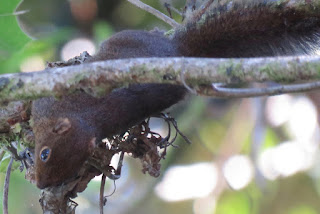


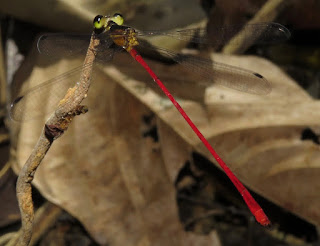

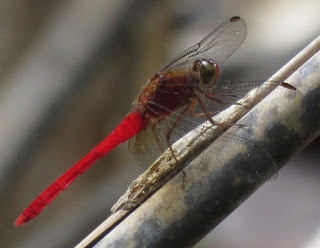



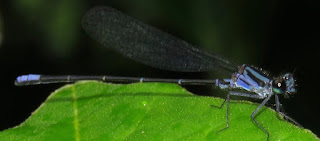






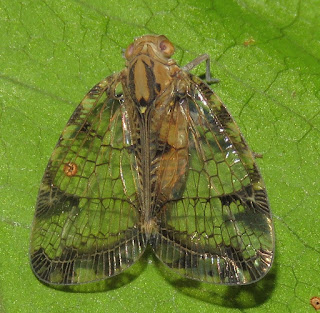

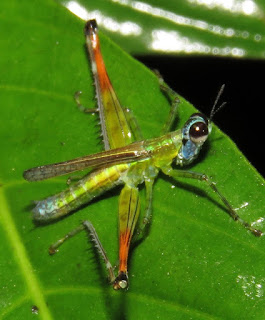

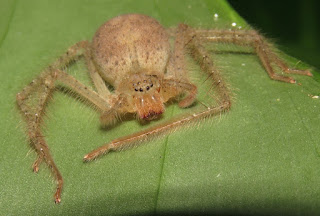







No comments:
Post a Comment